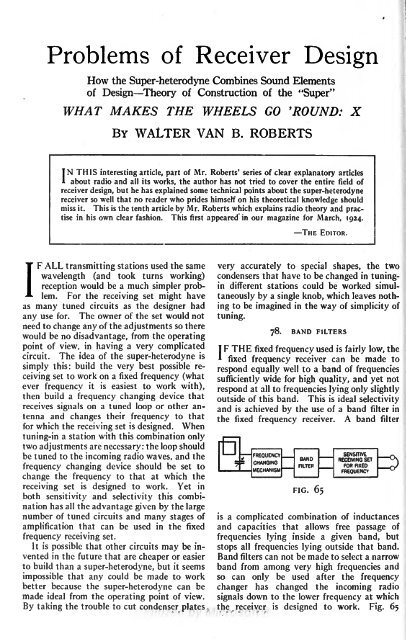Radio Broadcast - 1925, February - 113 Pages ... - VacuumTubeEra
Radio Broadcast - 1925, February - 113 Pages ... - VacuumTubeEra
Radio Broadcast - 1925, February - 113 Pages ... - VacuumTubeEra
Create successful ePaper yourself
Turn your PDF publications into a flip-book with our unique Google optimized e-Paper software.
Problems of Receiver Design<br />
How the Super-heterodyne Combines Sound Elements<br />
of Design Theory of Construction of the "Super"<br />
WHAT MAKES THE WHEELS GO 'ROUND: X<br />
BY WALTER VAN B.<br />
ROBERTS<br />
IN THIS interesting article, part of Mr. Roberts' series of clear explanatory articles<br />
about radio and all its works, the author has not tried to cover the entire field of<br />
receiver design, but he has explained some technical points about the super-heterodyne<br />
receiver so well that no reader who prides himself on his theoretical knowledge should<br />
miss it. This is the tenth article by Mr. Roberts which explains radio theory and practise<br />
in his own clear fashion. This first appeared in our magazine for March, 1924.<br />
THE EDITOR.<br />
ALL transmitting stations used the same very accurately to special shapes, the two<br />
wavelength (and took turns working) condensers that have to be changed in tuningin<br />
different stations could be worked simul-<br />
reception would be a much<br />
IF<br />
simpler problem.<br />
For the receiving set might have taneously by a single knob, which leaves nothing<br />
to be imagined in the way of simplicity of<br />
as many tuned circuits as the designer had<br />
any use for. The owner of the set would not tuning.<br />
need to change any of the adjustments so there<br />
would be no disadvantage, from the 78. BAND FILTERS<br />
operating<br />
point of view, in having a very complicated THE<br />
circuit. The idea of the super-heterodyne is IF fixed frequency used is fairly low, the<br />
fixed<br />
simply this: build the very best frequency receiver can be made to<br />
possible receiving<br />
set to work on respond a equally well to a band of<br />
fixed frequencies<br />
frequency (what<br />
ever frequency it is easiest to work sufficiently wide for high quality, and yet not<br />
with),<br />
respond at all to frequencies lying only slightly<br />
then build a frequency changing device that<br />
outside of this band. This is ideal selectivity<br />
receives signals on a tuned loop or other antenna<br />
and changes their frequency to that<br />
and is achieved by the use of a band filter in<br />
the<br />
for which the receiving set is<br />
designed. When<br />
fixed frequency receiver. A band filter<br />
tuning-in a station with this combination only<br />
two adjustments are necessary: the loop<br />
u<br />
should<br />
be tuned to the incoming radio waves, and the<br />
frequency changing device should be set to<br />
change the frequency to that at which the<br />
receiving set is designed to work. Yet in<br />
both sensitivity and selectivity this combination<br />
has all the advantage given by the large<br />
number of tuned circuits and many stages of<br />
amplification that can be used in the fixed<br />
frequency receiving set.<br />
It is possible that other circuits may be invented<br />
in the future that are cheaper or easier<br />
to build than a super-heterodyne, but it seems<br />
impossible that any could be made to work<br />
better because the super-heterodyne can be<br />
made ideal from the operating point of view.<br />
By taking the trouble to cut condenser plates
















